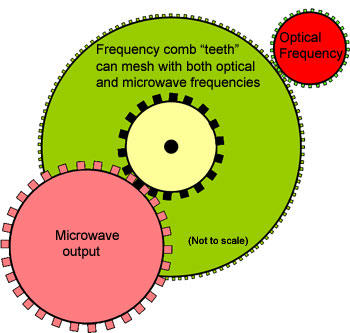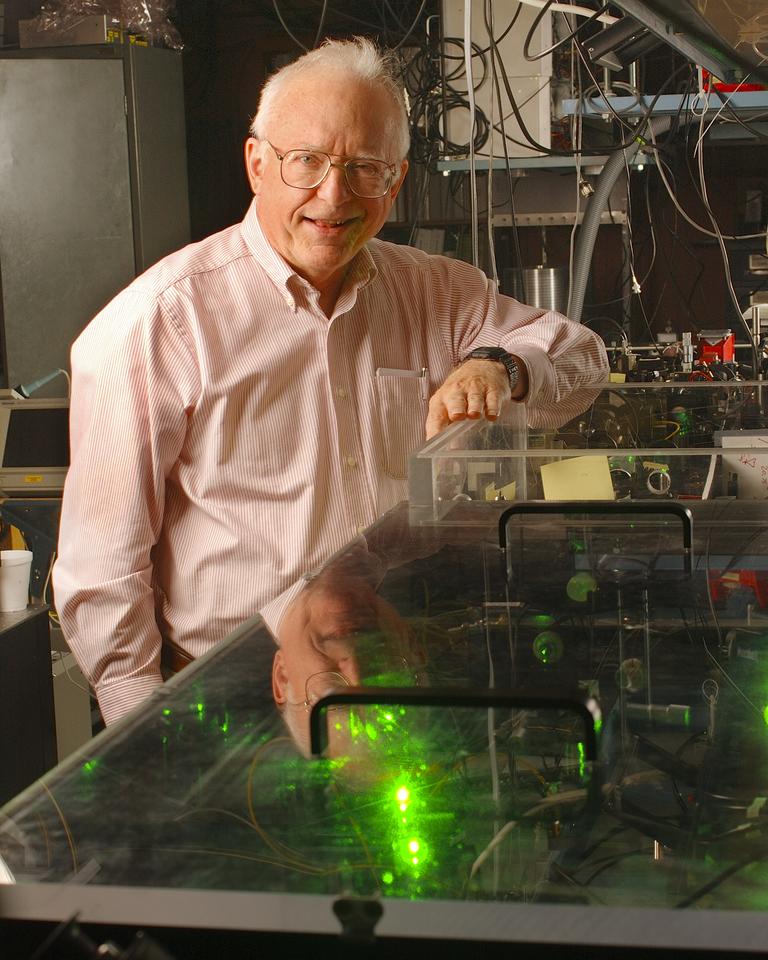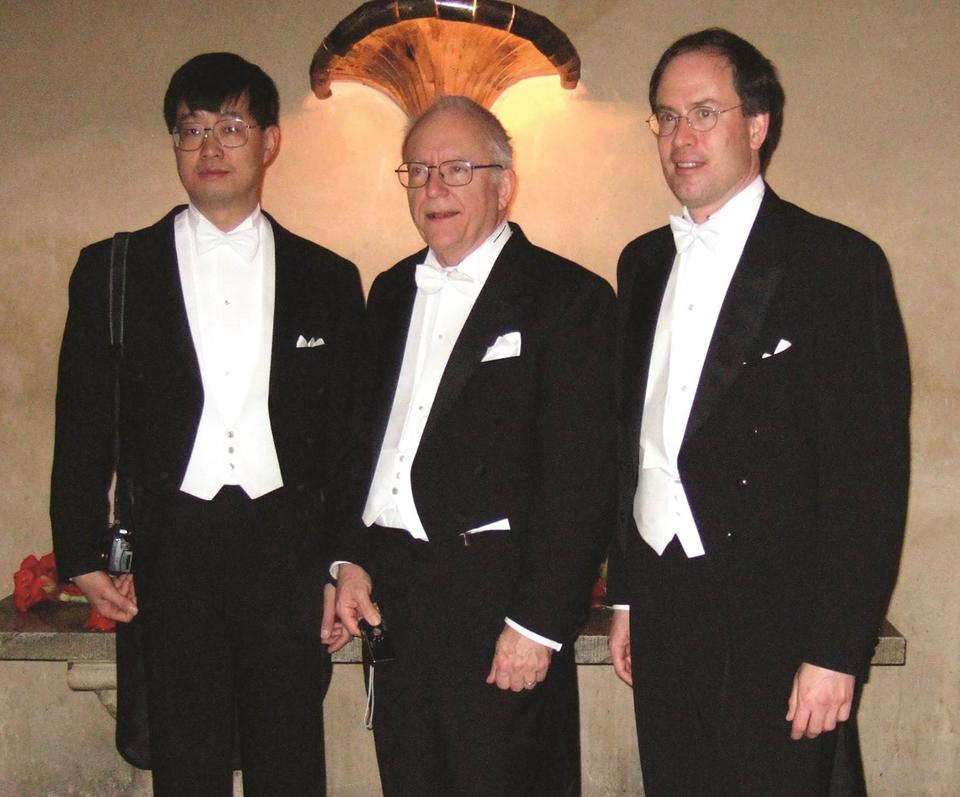The Nobel Moment: Jan Hall
Physicist Theodor Hänsch of the Max Planck Institute for Quantum Optics in Garching, Germany, proposed the optical frequency comb as far back as the 1970s. The concept is based on the fact that, unlike continuous-wave lasers, pulses from pulsed lasers contain not one, but many colors of light, each separated from its neighbors by a constant frequency interval. If there were a way to separate out each color into its own “tooth” on a comb, and to precisely know the frequency of each color, another laser could be interfered with the comb to produce beat patterns similar to those Ali Javan had demonstrated back in 1961. The frequency of the beating would reveal the unknown laser frequency. In other words, the comb would be like a meter stick for light.
Better yet, the beat pattern’s signal would be at a microwave or radio frequency, ratcheting ultrahigh optical frequencies down to a lower-frequency regime easily countable with electronics. In this way, a frequency comb would function like gears in a machine, or like the electronics in a conventional clock, converting mechanical motion into a time measurement. What once took rooms full of lasers and years to build could become a standard tool of science and commerce.

Laser technology would need nearly two decades to catch up with Hänsch’s visionary thinking. First, in the mid-1990s, researchers developed an ultrafast pulsed laser that produced red and infrared light inside sapphire crystals laced with the metallic element titanium. By forcing all the colors in the light pulse to start out in phase with each other, known as “mode locking,” the titanium-sapphire lasers could generate pulses just a few femtoseconds—millionths of a billionth of a second—in length, and in predictable intervals about a billion times each second. That’s a gigahertz, a frequency below the clock speed of contemporary home computers, and easy listening for oscilloscopes, electronic devices that can monitor electrical signals at these frequencies.
In addition to knowing the spacing between comb teeth, scientists needed a way to adjust, or “calibrate,” the comb to a known frequency. Hänsch realized this would be possible if a comb spanned an “octave” of frequencies, so that its highest frequency was at least double its lowest frequency. (Similarly, in music, the frequency of a note, such as ‘C,’ is double that of the note that is one octave lower, and half that of the note that is one octave higher.) By interfering a frequency with its double—a process called “self-referencing”— it would be possible to determine exactly what that frequency is. And with that information plus the tooth spacing, it would be possible to know every other frequency in the comb as well.
A comb spanning the optical spectrum—430 to 770 trillion cycles per second—would host a palette of about 400,000 distinguishable laser colors in each pulse, each frequency having its own “tooth.” Using the new titanium-sapphire lasers, Hänsch and his colleagues made progress toward the optical frequency comb at their Garching lab, but they couldn’t quite get the range they needed. Hall and his colleagues were also experimenting with ways to broaden the spectrum of light produced by continuous-wave lasers, inching toward a frequency comb, but they too fell well short of the octave.

In the late 1990s, after a nearly 40-year career at JILA, Hall was considering retirement. But the arrival of key collaborators set the stage for a dramatic last act. Steven Cundiff joined the University of Colorado as a JILA fellow in 1997. He was an expert in short-laser-pulse techniques and brought with him a titanium-sapphire mode-locked laser that he had built at Bell Labs, where he had worked previously.

In addition, two postdoctoral fellows, Scott Diddams and David Jones, were brought on to assist in the summer of 1998, Diddams in Hall’s group and Jones in Cundiff’s group. Hall visited Hänsch’s lab in 1998 and saw the group’s prototype frequency comb. Hall realized he and Cundiff had the necessary tools to advance the technology, and he embraced ultrafast mode-locked lasers.
“When the frequency comb work started, Jan said, ‘It’s such an exciting time, it’s impossible to retire!’” recalls Hall’s colleague Jun Ye, a JILA and NIST-Boulder fellow. Jun Ye returned to JILA as a Fellow in 1999.
The team built a calibration system to allow the femtosecond laser to generate a series of pulses with a controllable, well-defined relationship between successive pulses and the positions of the thousands of laser colors inside it. All that was missing was a way to produce a full octave of frequencies.

The final piece appeared at a conference in May 1999, when Jinendra Ranka, a scientist from Bell Laboratories (then owned by Lucent Technologies) unveiled a hair-thin strand of optical fiber specially designed to carry light. Surrounding the fiber’s glass core were dozens of micron-wide, honeycombed tunnels. Blasting laser pulses through the core confined by the airholes generated a huge electric field, which, thanks to the fiber’s design, broadened the spectrum of laser light in each pulse beyond the octave Hall’s team needed.
Hall and his colleagues descended on Ranka after his talk and asked how they could get a piece of the optical fiber. A short time later, Hänsch and Hall tried to get people they knew at Bell Labs to ship them a fiber while they were together on a Hänsch lab retreat in Germany, but company lawyers initially refused to share the technology out of concerns about intellectual property. After Cundiff used his connections with his former Bell Labs colleagues, a package containing around a meter of fiber finally arrived at JILA on October 4, 1999. Just two days later, the scientists had combined the fiber with their mode-locked laser and associated electronic control system to produce sharp comb teeth at regular intervals—the first time anyone had achieved this. On October 16, Diddams and Jones used the first octave-spanning, self-referenced optical frequency comb to measure the frequency of a Hall-lab rubidium-stabilized laser.
“This was the comb we all had dreamed about,” Hall says. “It was a huge joy to have something in your mind, and then find out that nature doesn’t deny you the chance to see it.”
“Looking back, there were, in some ways, unplanned surprises, and also some good luck, in being in the right place at the right time with the right tools that could make all of this research come together,” adds Diddams. “But I think that in all of it, Jan had a sharp sense of the right direction to go … so we could get to the end goal really quickly.”
When they published an early study in 2000, Hall insisted on including Hänsch’s group, which had contributed many important ideas and technologies to the quest, as co-authors. The group in Garching had lacked only what Hall called the “magic fiber” from Bell Labs, though Hänsch later discovered that a company in Germany had been producing a similar fiber for years.
“It’s the way Jan operated his entire career—really sharing ideas for the benefit of the entire community,” Diddams says.

“Jan is a very kind person. He’s extremely embedded into science. Science is the only thing that really gets him excited. He’s an electronics wizard—he’s really the best electronics person I’ve seen. He continues to be very interested in making new electronics which helps in making lasers better.”
– Jun Ye, JILA Fellow and former Jan Hall postdoc

